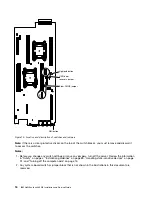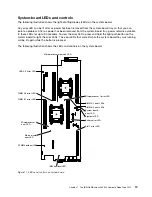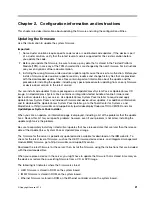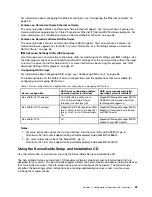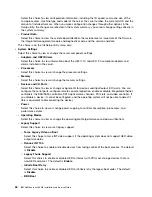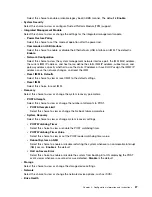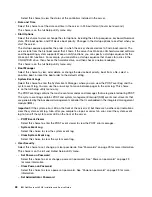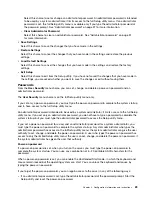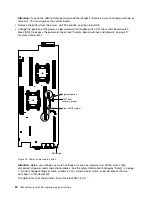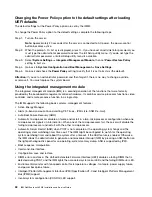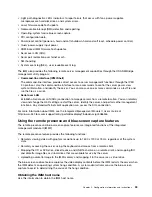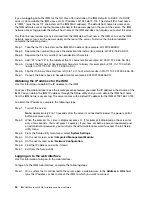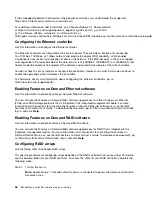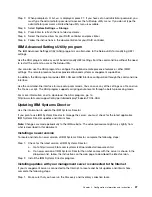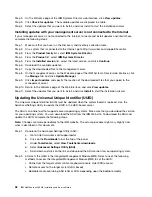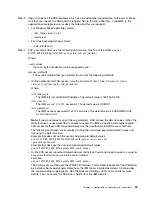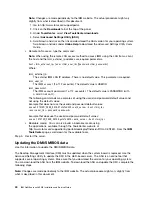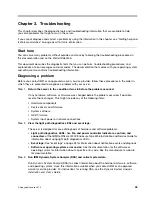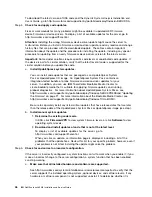
Changing the Power Policy option to the default settings after loading
UEFI defaults
The default settings for the Power Policy option are set by the IMM2.
To change the Power Policy option to the default settings, complete the following steps.
Step 1.
Turn on the server.
Note:
Approximately 20 seconds after the server is connected to AC power, the power-control
button becomes active.
Step 2.
When the prompt
<F1> Setup
is displayed, press
F1
. If you have set an administrator password, you
must type the administrator password to access the full Setup utility menu. If you do not type the
administrator password, a limited Setup utility menu is available.
Step 3.
Select
System Settings
➙
Integrated Management Module
, then set
Power Restore Policy
setting to
Restore
.
Step 4.
Go back to
System Configuration and Boot Management
➙
Save Settings
.
Step 5.
Go back and check the
Power Policy
setting to verify that it is set to
Restore
(the default).
Attention:
If you set an administrator password and then forget it, there is no way to change, override,
or remove it. You must replace the system board.
Using the integrated management module
The integrated management module (IMM) is a second generation of the functions that were formerly
provided by the baseboard management controller hardware. It combines service processor functions, video
controller, and remote presence function in a single chip.
The IMM supports the following basic systems-management features:
• Active Energy Manager.
• Alerts (in-band and out-of-band alerting, PET traps - IPMI style, SNMP, e-mail).
• Auto Boot Failure Recovery (ABR).
• Automatic microprocessor disable on failure and restart in a two-microprocessor configuration when one
microprocessor signals an internal error. When one of the microprocessors fail, the server will disable the
failing microprocessor and restart with the other microprocessor.
• Automatic Server Restart (ASR) when POST is not complete or the operating system hangs and the
operating system watchdog timer times-out. The IMM might be configured to watch for the operating
system watchdog timer and reboot the system after a timeout, if the ASR feature is enabled. Otherwise,
the IMM allows the administrator to generate a nonmaskable interrupt (NMI) by pressing an NMI button on
the light path diagnostics panel for an operating-system memory dump. ASR is supported by IPMI.
• Boot sequence manipulation.
• Command-line interface.
• Configuration save and restore.
• DIMM error assistance. The Unified Extensible Firmware Interface (UEFI) disables a failing DIMM that is
detected during POST, and the IMM lights the associated system error LED and the failing DIMM error LED.
• Environmental monitor with fan speed control for temperature, voltages, fan failure, power supply failure,
and power backplane failure.
• Intelligent Platform Management Interface (IPMI) Specification V2.0 and Intelligent Platform Management
Bus (IPMB) support.
• Invalid system configuration (CONFIG) LED support.
32
IBM NeXtScale nx360 M4 Installation and Service Guide
Summary of Contents for NeXtScale nx360 M4
Page 1: ...IBM NeXtScale nx360 M4 Installation and Service Guide Machine Type 5455 ...
Page 6: ...iv IBM NeXtScale nx360 M4 Installation and Service Guide ...
Page 34: ...20 IBM NeXtScale nx360 M4 Installation and Service Guide ...
Page 58: ...44 IBM NeXtScale nx360 M4 Installation and Service Guide ...
Page 94: ...80 IBM NeXtScale nx360 M4 Installation and Service Guide ...
Page 192: ...178 IBM NeXtScale nx360 M4 Installation and Service Guide ...
Page 538: ...524 IBM NeXtScale nx360 M4 Installation and Service Guide ...
Page 562: ...548 IBM NeXtScale nx360 M4 Installation and Service Guide ...
Page 722: ......
Page 730: ......
Page 737: ......
Page 738: ...Part Number 00KC216 Printed in China 1P P N 00KC216 1P00KC216 ...

